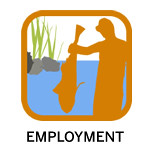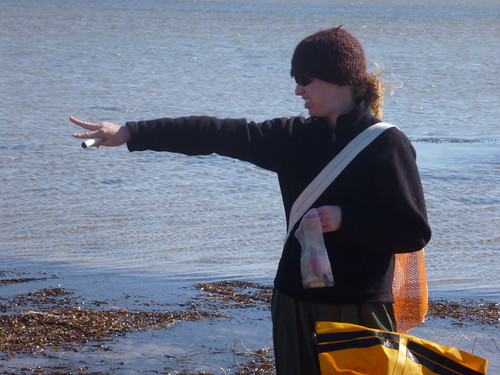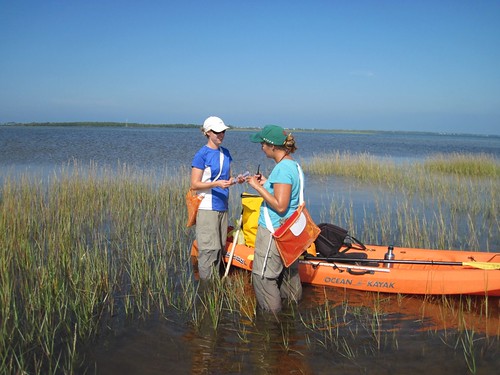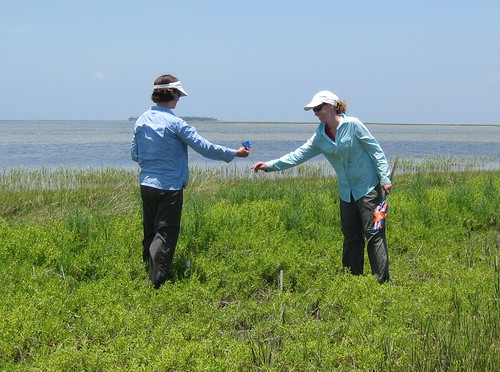Emily Field FSU Coastal & Marine Lab
 You’ve heard about research from a lab tech’s perspective from Tanya, and from a Principle Investigator (PI)’s perspective from Randall and David, so I thought I’d give you a graduate student’s insight. Being a grad student is kind of like being a mash-up of a tech, a student, and a PI: you do a lot of the “dirty work,” but you also have to be able to direct other students and manage your own research. You’re taking classes, but you’re also teaching. You’re writing grant proposals for future projects, but you’re also trying to figure out how to analyze data from past projects. And while this might sound hectic enough to create split personalities, I love it! I get to develop my own projects, take challenging and interesting classes, and help Randall with her projects. In fact, my favorite thing about work is that it’s such a tumbled mix of things: my time is split between the lab, field, classroom, and desk. Life as a grad student is never boring!
You’ve heard about research from a lab tech’s perspective from Tanya, and from a Principle Investigator (PI)’s perspective from Randall and David, so I thought I’d give you a graduate student’s insight. Being a grad student is kind of like being a mash-up of a tech, a student, and a PI: you do a lot of the “dirty work,” but you also have to be able to direct other students and manage your own research. You’re taking classes, but you’re also teaching. You’re writing grant proposals for future projects, but you’re also trying to figure out how to analyze data from past projects. And while this might sound hectic enough to create split personalities, I love it! I get to develop my own projects, take challenging and interesting classes, and help Randall with her projects. In fact, my favorite thing about work is that it’s such a tumbled mix of things: my time is split between the lab, field, classroom, and desk. Life as a grad student is never boring!
I moved to Florida in May 2009, right after graduating from University of Rhode Island, and worked for Randall as a tech before starting school in the fall. It was a great way to familiarize myself with the system and learn appropriate sampling techniques for the area. I came in thinking that I wanted to work with epiphytes (small seaweeds that grow on other plants/seaweed) on seagrass. I did develop a project working with Chris Stallings on his huge Big Bend survey looking at the epiphytes throughout the region, but as I was working for Randall, I became more and more interested in developing my own project in the salt marsh. I am now studying the effects of wrack in the marsh. The epiphyte project is ongoing, and a marine certificate student, Michele Sosa, took over the project this summer so that I would have more time to develop my wrack research.
Learn more about Emily’s seagrass wrack study.
I think that is one thing I’ve learned as a grad student: there’s so much you could do, that it can be hard at first to pick one thing to develop into an interesting and informative project. If you’re not careful, you might end up with a bunch of semi-related “side projects.” I definitely owe Randall a lot for helping me stay focused and develop a clear project with a solid theoretical basis. As Tanya said, when there is a lot of work to do, it’s easy to get bogged down in the details and forget the big picture –which you definitely can’t do when you’re in charge of the project!
The other trick to grad school is balance, which can have a steep learning curve! One of the first things they tell you when you enter school as a graduate student is that you’re expected to work 60 hours a week: 20 on your coursework, 20 on teaching or your advisor’s research (depending on what you’re being paid for), and 20 on your own research. Of course, every week does not break down into this perfect division, but I think the main point to remember is to balance all of your responsibilities. Which is much, much easier said than done. As I’m writing this post, I’m thinking about the various other tasks I should probably be doing. My bugs need sorting, that paper needs reading, those buckets need mending… the list goes on. But, hey, I knew what I signed up for when I decided to go to grad school. I was warned. However, if you ever see me talking to myself, do me a favor and send for the nice men in the white coats?
Watch Emily survey seagrass beds and learn more about epiphytic algae.




3 comments
Good post! As a fellow graduate student, I know exactly what you are talking about! I came to Stony Brook with a specific project, and it has evolved considerably in my time here. Good luck in the future.
As a side note, when I started reading the blog post, I read Emily and URI, it clicked that I had just recently read a manuscript just published in MEPS in which you were a co-author. Congrats Emily!
Thanks John! It’s nice to know that people are reading the manuscript, as well as this blog. Your blog looks really neat too.
[…] as well. If you’ve been following this blog, you’ve read about Emily Field’s graduate work on seagrass wrack and Kattie Lotterhos’ graduate work in genetics. In David’s lab, we’ve heard […]
Comments are closed.